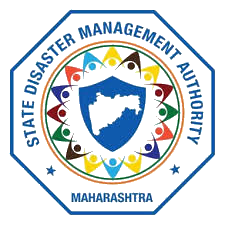Maharashtra is prone to multiple hazards, including landslides, floods, cyclone, earthquake, drought and lightning strikes. The Western Ghats and Konkan region exhibit a high susceptibility to landslides, induced by heavy rainfall patterns and anthropogenic activities, heavily impacting the districts of Raigad, Pune, Ratnagiri, Sindhudurg, and Palghar. Flooding, mainly during monsoons, affects cities like Mumbai, Pune, Nagpur, and villages, with coastal and riverine areas at high risk. Maharashtra is seismically active due to its complex geology, with Mumbai and Thane in the high-risk Zone IV, Pune and Nashik in the moderate-risk Zone III, and southeastern regions like Nagpur in the low-risk Zone II, experiencing occasional tremors. The state’s long Arabian Sea coastline, once considered less prone to cyclones, now faces increasing storm threats due to climate change. Coastal districts such as Mumbai, Raigad, Ratnagiri, Sindhudurg, and Palghar are particularly at risk, experiencing heavy rainfall, strong winds, storm surges, and flooding. Recurring droughts, pose a persistent threat to agricultural productivity and water resource availability. Lightning strikes, especially prevalent in eastern Maharashtra, notably in Chandrapur and Nagpur, present a serious hazard to human life, agricultural yields, and livestock.
Hazard, Vulnerability, Risk Overview
Drought:
Maharashtra faces severe and repeated droughts that impact millions of people, agriculture, and water supplies. The Drought Frequency Index (DFI) Map shows how vulnerable different areas are to drought, using data from 1901 to 2021. Drought Frequency Index (DFI) was developed by using the Standardized Precipitation Evapotranspiration Index (SPEI) for the monsoon months, study done by the Water and Climate Lab at IIT Gandhinagar, pinpoint areas at high risk for drought based on the last century’s data. Drought Frequency Index is done by Project Management Unit of SDMA and it categorizes where and how often droughts happen in Maharashtra.
Landslide:
Landslides are a major natural disaster in Maharashtra, especially in the Western Ghats and Konkan region, posing threats to lives, infrastructure, and the environment due to heavy rainfall, unstable slopes, deforestation, and human activities. Maharashtra’s geography makes it prone to landslides, necessitating mitigation efforts.
Districts like Raigad, Ratnagiri, Pune, Sindhudurg, Satara, Kolhapur, Ahmednagar, and Sangli are highly susceptible to landslides. The Konkan region’s steep terrain and heavy monsoons, and deforestation in the Western Ghats, contribute to frequent landslides. GSI data on landslide events reveals Raigad (175 events, 106 villages), Pune (237 events, 144 villages), and Ratnagiri (273 events, 166 villages) as the most affected.
Flood:
Flooding in Maharashtra is increasing, affecting millions of people and causing significant damage. The State Disaster Management Authority (SDMA) monitors flood patterns and works on solutions. Maharashtra faces different types of flooding. Riverine flooding happens during heavy monsoon rains. Urban flooding occurs in cities due to poor drainage. Coastal flooding results from high tides.The Konkan region, including Mumbai, is at high risk for both coastal and riverine flooding due to intense rain and rivers like the Vashishti. In Western Maharashtra, areas like Pune experience flooding from rivers such as the Krishna. Cities like Mumbai, Pune, and Nagpur see more urban flooding because of land encroachment, weak drainage systems, and heavy rainfall. Mumbai regularly faces monsoon floods, notably in 2019, 2020, 2021, and 2023. These floods disrupt daily life as the Mithi River overflows and high tides occur.
Lightning:
Lightning is a serious natural hazard, and Maharashtra, with its diverse climate, is prone to frequent strikes, especially during monsoon seasons. A study by the SDMA’s Project Management Unit has identified high-risk zones and the growing impact of lightning-related incidents. The study shows that lightning flash density in Maharashtra ranges from 0.1 to 4.5 flashes per square kilometer per year, highlighting the need for targeted mitigation and early warning systems. Eastern Maharashtra, particularly Chandrapur and Nagpur, is a lightning hotspot with high flash densities, posing significant risks to human life, agriculture, and livestock.
Earthquake:
Maharashtra, a heavily industrialized and populated Indian state, is prone to earthquakes due to its complex geology. Though less seismically active than the Himalayas, past earthquakes highlight the need for preparedness in Maharashtra. The state’s susceptibility to seismic hazards is due to the presence of faults and tectonic movements within the Deccan Plateau. Maharashtra is divided into different seismic zones by the Bureau of Indian Standards (BIS), based on earthquake probability and intensity. Zone IV (High-Risk Zone) includes Mumbai and Thane in northern and western Maharashtra, prone to high-intensity earthquakes due to their proximity to the Western Ghats and geological faults. Zone III (Moderate-Risk Zone) covers a large part of Maharashtra, including Pune and Nashik, experiencing occasional tremors. Zone II (Low-Risk Zone) covers southeastern and eastern regions like Nagpur, with a lower probability of strong earthquakes. Despite being situated on the stable Deccan Plateau, Maharashtra has experienced destructive earthquakes due to intraplate seismic activity.
Cyclone:
Maharashtra, despite having a long coastline along the Arabian Sea, was historically considered less prone to cyclones. However, in recent years, the frequency and intensity of cyclonic storms have increased due to climate change and rising sea surface temperatures. Cyclones pose a severe threat to coastal districts like Mumbai, Raigad, Ratnagiri, Sindhudurg, and Palghar, causing heavy rainfall, strong winds, storm surges, and flooding. These extreme weather events lead to loss of life, damage to infrastructure, disruption of livelihoods, and destruction of crops.


